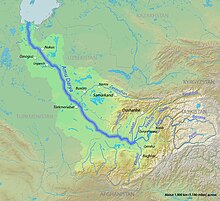Battle of the Oxus (399)
This article is an orphan, as no other articles link to it. Please introduce links to this page from related articles; try the Find link tool for suggestions. (October 2024) |
| Battle of the Oxus | |||||||||
|---|---|---|---|---|---|---|---|---|---|
| Part of Chandragupta II's Huna expeditions and Gupta–Hunnic Wars | |||||||||
 Map of the Amu Darya's watershed in Central Asia, that drains parts of Afghanistan, Uzbekistan, Turkmenistan, and Tajikistan into the Aral Sea | |||||||||
| |||||||||
| Belligerents | |||||||||
| Gupta Empire |
Transoxiana Alliance
| ||||||||
| Commanders and leaders | |||||||||
| Chandragupta II the great | Unknown | ||||||||
| Casualties and losses | |||||||||
| unknown | Hunas slaughtered[a] | ||||||||
The Battle of the Oxus (Vankshu) happened in 399 CE when Chandragupta II defeated the Hunas at the banks of the Oxus river.[5][b]
Background
[edit]Submission of Varahran
[edit]After the (Persian) Sasanians faced defeat in the Battle of Sistan, which demoralized the Persian contingents in present-day Afghanistan. As the Gupta Army marched northwards to Kapisa, Varahran was quick to grasp the political realities and offered his submission to the Gupta Emperor, Chandragupta II.[7]
Gupta cavalry's arrival by the Oxus river
[edit]Bactria was under the Huna occupation in the last quarter of the fourth century AD.[8] The sudden attack into the Oxus valley caught the Transoxiana alliance off-guard. The Pamir Tocharians were unable to combine with the Hunas (Hephtalites). On hearing the news of the Gupta Empire advanced, the Hephtalites resorted to a tactical retreat to the north of the Oxus River into the plains of Southern Uzbekistan. When the Gupta cavalry arrived by the Oxus river on the southern banks, they camped there. Kalidasa poetically described how the cavalry camped on the banks of the river Vankshu in the midst of saffron fields in a verse of his Raghuvamsa:
"...His horses, that had lessened their fatigues of the road by turning from side to side on the banks of the river Vankshu (Oxus), shook their shoulders to which were clung the filaments of saffron..."
Historians studied this as a description of the Gupta cavalry camping on the banks of the Oxus during Chandragupta II's expedition.[9][10]
Notes and Aftermath
[edit]- ^ Kalidasa describes the gloomy aftermath of the Hunnic defeat in the Oxus valley when the Hunnic women scarred their faces as was the ancient custom of cutting the faces of the wives of deceased warriors in battle. To quote the poet:
[4]"...There (in the Vanskhu valley)... the power (of the exploits of the Indian emperor) of which was clearly seen in (the slaughter of) the husbands of the young (Huna) women (when) in the inner apartments of the camps of the Huna Kings, (these exploits of the Indian army) proved a teacher of ruddiness in their cheeks (which were self-scarred following their Huna culture)..."
- ^ "We get some informations about the Hūṇas from Kālidāsa, who in his Raghuvaṃśa places them on the banks of the river Oxus where they were defeated by Raghu. Taking Kālidāsa to be a contemporary of Chandragupta II, we can conclude that the Hūṇas had occupied Bactria in the last quarter of the fourth century AD." [6]
References
[edit]- ^ "It is thus settled that Kālidāsa located the Hūnas conquered by Raghu on the bank of the river Vankshu or Oxus rather than the Sindhu or the Indus."Prakash, Buddha (1962). Studies in Indian History and Civilization. Shiva Lal Agarwala. p. 282.
- ^ Prakash, Buddha (1962). Studies in Indian History and Civilization. Shiva Lal Agarwala. p. 282.
- ^ Prakash, Buddha (1962). Studies in Indian History and Civilization. Shiva Lal Agarwala. p. Chapter XIII.
- ^ Agrawal 1989, p. 165.
- ^ Prakash, Buddha (1962). Studies in Indian History and Civilization. Shiva Lal Agarwala. p. Chapter XIII and Chapter XIV.
- ^ " Taking Kālidāsa to be a contemporary of Chandragupta II, we can conclude that the Hūṇas had occupied Bactria in the last quarter of the fourth century AD. " Agrawal 1989, p. 240
- ^ "The Raghuvamsa Of Kalidasa. With The Commentary Of Mallinatha by Nandargikar, Gopal Raghunath: used/Good rebound full cloth (1982) | Prabhu Book Exports". www.abebooks.co.uk. p. verse 66, Chapter XIII. Retrieved 2024-03-22.
- ^ Agrawal 1989, p. 166.
Bibliography
[edit]( Agrawal, Ashvini (1989). Rise and Fall of the Imperial Guptas. Motilal Banarsidass. ISBN 978-81-208-0592-7.
